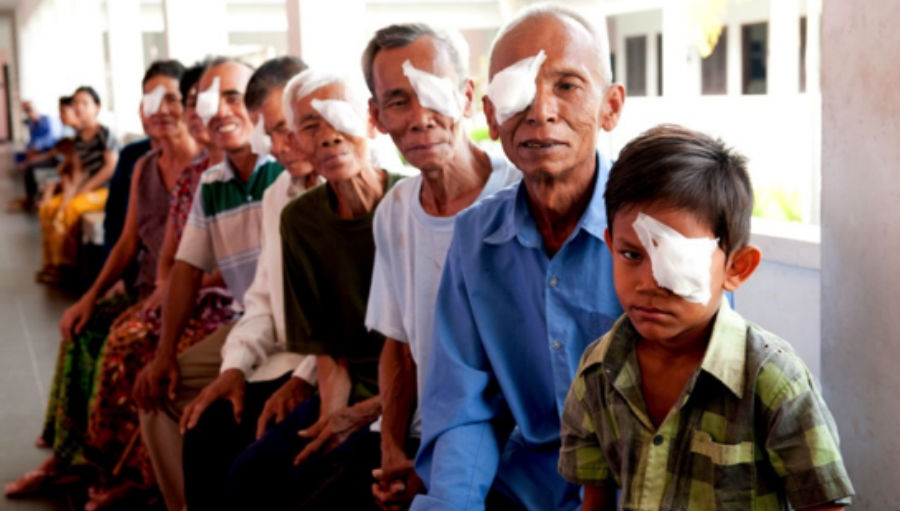Join a powerful, unprecedented alliance for better eye health for all.
Join IAPB-
Choose an alternate language here
David Lewis, CBM Focal Point for Environmental Sustainability, and Kirsty Smith, Chief Executive of CBM UK, on an important opportunity to promote environmental sustainability in the eye-health sector amid a month of climate disaster.

However there is hope and CBM is determined to do our bit to improve the sustainability of all of our work. In September we logged in via Skype to Kathmandu to join the launch of an international working group for environmental sustainability, one of our biggest priorities if we are to see global health of the world’s poorest people improve.
The group has been set up by the International Agency for the Prevention of Blindness (IAPB) after a proposal from member organisations including CBM, Vision 2020 UK, Aravind Eye Care System as well as other interested individuals.
Our aim is to bring together well-researched and creative approaches to strengthen environmental sustainability in eye health organisations around the world.
Climate change and environmental degradation have a devastating impact on all parts of the world, but this is particularly true for the world’s poorest communities. What drives our determination is knowing people with disabilities and other vulnerable groups are among those most affected on a daily basis, and in every part of their lives.
Health and well being are at risk in polluted and dangerous environments. These communities often lack access to safe water and sanitation, to sustainable food and energy sources. They face increasing risks due to natural and man-made disasters and more often than not find themselves at the back of the relief aid queue.
In terms of eye health, we know that the communities most susceptible to environmental degradation carry some of the highest rates of avoidable and permanent blindness.
CBM is acutely aware that climate change is predicted as one of the largest health threats of the 21st century and that health care itself is a large contributor to carbon emissions. Working closely with high quality eye health services around the world puts CBM in a strong position to draw attention to the essential need to reduce carbon emissions.
Environmental sustainability and inclusion have been at the heart of CBM’s work for many years. We want to improve the environment and at the same time make sure people with disabilities and those from other marginalised groups participate in environmental programmes as their human right. Thanks to advocacy by CBM and others, the Agenda 2030 for Sustainable Development Goals agreed by world leaders in September 2015, became much more inclusive.
CBM has created a resource booklet to help and inspire those seeking to make eye health services, and health and development programmes generally, more environmentally sustainable. It includes case studies, checklists and ideas with input from our global advisors and partners in the field. We want to demonstrate the wide ranging actions possible to strengthen environmental sustainability, particularly in the poorest countries, and gather evidence of the effectiveness of CBM’s actions so that we can replicate our most effective interventions elsewhere. As well as environmental sustainability and inclusion, this booklet highlights the need for accessibility, gender equality, safe-guarding those at risk, and disaster risk reduction as keys to sound development practice.
We were delighted to have one of our case studies highlighted at the IAPB Council meetings in Kathmandu, as an effective model of environmental sustainability which others in the field can learn from, as well as contributing their own ideas.
We are particularly proud of what has been achieved during our partnership with the Caritas Takeo Eye Hospital from 1996 – 2013.
Cambodia is one of the poorest countries in Asia, with the majority of the population living in poor rural areas, with low access to services. Blindness is a key factor contributing to this poverty.
It was in 2006 when the chance came to innovate in all areas of hospital life. The old hospital had to be demolished and all the stake-holders wanted the new one, from its construction, energy and water supplies, to its cooking equipment and even surgery techniques to be of the lowest impact on the environment possible. The hospital is proving to be a great model, with ongoing assessment of things which could be improved.
The hospital offers excellent eye care in accessible buildings which like many of the other facilities are above ground to reduce the threat from flooding. The “3 R’s” are used every day – reduce recycle re-use.
CBM hopes the Cambodia study will help other IAPB members strengthen high quality environmental practices and widen inclusivity in their own eye hospitals.
As a result of this and other expertise recognised within CBM, we had the opportunity to be one of the leads in setting up the Environmental Sustainability Work Group for the IAPB.
Its launch in Kathmandu was a great success with CBM and other IAPB members setting out ambitious plans for innovation and learning, so that the best community eye services can be available while minimising their economic and environmental impact.
We are making progress. Our determination to put the environment and inclusion at the epicenter of the fight against poverty and inequality is moving forward.
Image: patients after cataract surgery at Caritas Takeo Eye Hospital, Cambodia. Open, airy verandahs allow for air movement, keeping the hospital cooler and creating a pleasant environment for patients to wait. © CBM